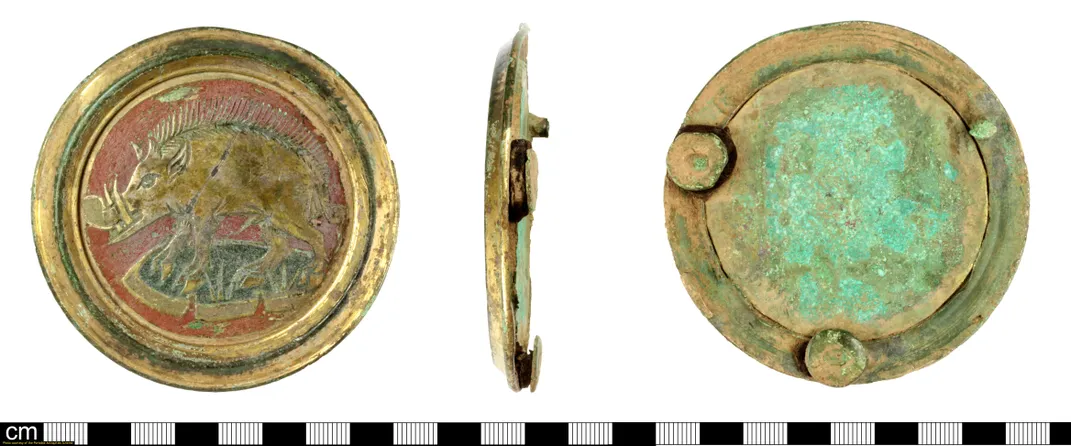Gardeners Unearth Coins Inscribed With Initials of Henry VIII’s First Three Wives
The find is one of more than 47,000 recorded by the U.K.’s Portable Antiquities Scheme in 2020
:focal(2036x1221:2037x1222)/https://tf-cmsv2-smithsonianmag-media.s3.amazonaws.com/filer/a9/7b/a97bbf7e-c3cd-418b-8eb1-77d22fc7525f/2020_t333_group_shot_medium.jpg)
In 1526, Henry VIII and his chief advisor, Cardinal Thomas Wolsey, reformed England’s coinage in hopes of regulating the kingdom’s economy. As part of the project, the Tudor king introduced new denominations—gold crowns—with an unexpected feature: the initials of his queen consort, Catherine of Aragon.
Seven years later, when Henry divorced Catherine to marry Anne Boleyn, the Royal Mint issued a new set of crowns inscribed with the letter “A.” Three years after that, when Henry had Anne beheaded on trumped-up charges of adultery, incest, witchcraft and conspiring to kill him, the Mint produced yet another gold coin, this time dedicated to the monarch’s latest queen, Jane Seymour.
Though Henry married three more times, his later wives (Anne of Cleves, Catherine Howard and Catherine Parr) never appeared on the kingdom’s currency—perhaps a wise decision considering the difficulty of keeping up with an ever-shifting cast of queens.
This spring, four such rare Tudor tokens turned up in the New Forest area of southern England, where a British family weeding its garden during Covid-19 lockdown unearthed a trove of 64 medieval coins. Per a statement from the British Museum’s Portable Antiquities Scheme (PAS), which is responsible for tracking the English and Welsh public’s archaeological finds, the collection includes 63 gold coins and one silver coin dated to between the late 15th and early 16th centuries.
/https://tf-cmsv2-smithsonianmag-media.s3.amazonaws.com/filer/6a/4f/6a4f973e-f72f-49f5-946f-0fad126861ac/my_post_2.jpg)
“They were out turning up the soil and all of a sudden these coins popped out of the ground … miraculously,” Ian Richardson, the museum’s treasure registrar, tells the Guardian’s Mark Brown. “It is quite a shocking find for them and very interesting for us.”
In total, the trove spans the reigns of five British monarchs: Edward IV, Edward V, Richard III, Henry VII and Henry VIII. At the time of their burial around 1540, the coins were worth £24, or £14,000 (almost $18,500 USD) today—a “great deal of money, certainly more than the annual wages of the average person,” says Barrie Cook, a curator of medieval and early modern coins at the museum, to the Guardian.
The majority of the coins are “angels” depicting Saint Michael slaying a dragon. The gold crowns bearing the royals’ initials, meanwhile, feature the Tudor rose and shield of arms.
Researchers are unsure whether the coins’ owner buried them all at once or made regular deposits over time. John Naylor, a coin expert at the University of Oxford’s Ashmolean Museum, posits that a wealthy merchant or clergy member buried the hoard in response to Henry’s Dissolution of the Monasteries.
“[S]ome churches did try to hide their wealth, hoping they would be able to keep it in the long term,” Naylor tells the Guardian.
As Ben Johnson explains for Historic U.K., Henry, who’d broken from the Catholic Church in 1534 to wed Anne, ruthlessly dissolved the kingdom’s monasteries as part of England’s Protestant Reformation. Aided by advisor Thomas Cromwell, the king spent the late 1530s and ’40s shutting down houses of worship, seizing their land and wealth, and engaging in iconoclastic destruction. In doing so, he both eliminated symbols of the papacy and filled his dwindling coffers with funds from the Church’s treasures.
Writing for COINage magazine in 2018, R.W. Julian noted that the 1526 currency overhaul marked Henry’s first experiment with debasement, or the practice of lowering coins’ worth but maintaining their face value by increasing the percentage of everyday metals mixed in with precious metals like gold or silver. Officials used the extra gold and silver to mint additional coins, theoretically making more funds available but, in practice, sparking widespread inflation.
Toward the end of his reign, Henry embarked on a similar economic venture, replacing coins’ precious metal content with cheaper base metals to such an extent that the policy was later dubbed the Great Debasement. Per a 2011 journal article by scholar Stephen Deng, the king, who “had already exhausted the bounteous resources he had acquired from the dissolution of the monasteries,” hoped to exploit England’s coinage to fund military campaigns in France, Scotland and Ireland. Following Henry’s death in 1547, his son Edward VI continued the practice, which only came to an end in 1551.
The Tudor coins are among more than 47,000 archaeological finds made in England and Wales this year, the British Museum said on Wednesday. Other key discoveries included a collection of 50 apartheid-era South African gold coins; a medieval mount featuring a white boar, the personal emblem of Richard III; and a copper Roman furniture fitting. Officials reported that Covid-19 lockdowns led to an uptick in finds, with many pandemic-worn Brits seeking respite in their gardens.
/https://tf-cmsv2-smithsonianmag-media.s3.amazonaws.com/accounts/headshot/mellon.png)

/https://tf-cmsv2-smithsonianmag-media.s3.amazonaws.com/filer/65/69/656989f9-9df6-416c-9c24-190bf2f27097/2020_t333_fingers_-_fixed.jpg)
/https://tf-cmsv2-smithsonianmag-media.s3.amazonaws.com/filer/66/7e/667e6cb3-5ddf-4b60-ad54-b1f4359eeb29/buc-944e2c_-_2020_t345_-_coins_and_containers.jpg)
/https://tf-cmsv2-smithsonianmag-media.s3.amazonaws.com/accounts/headshot/mellon.png)